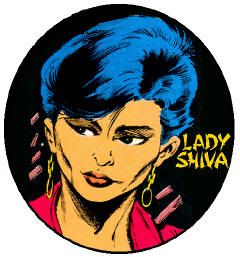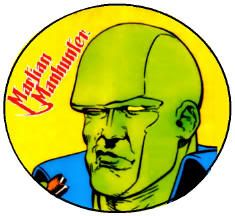 Classic X-Men #6
Classic X-Men #6 reprinted The All-New, All-Different X-Men from 1976, moving a barely visible Cockrum Wolverine from deep in the background to an Arthur Adams cover sharing the spotlight with Jean Grey well into the foreground. I'm pretty sure
Elfquest was boring the pants off me by #19, but I think I was still hanging on.
I always think
The Official Handbook of the Marvel Universe Deluxe Edition ran longer than twenty issues, but as with the original version, it effectively ends with #15. Also like the first edition though, when the core coverage resolves, the book moves into addendum with the books of the dead and inactive. There's no need for a paraphernalia issue since that was all incorporated into the individual enties in the Deluxe Edition, but Marvel couldn't miss the chance to out-morbid itself with five issues of spectral heroes and villains rising from the grave. But those arrive bi-monthly sometime next year, so we'll stop Wonder Man to Zzzax, Plus Appendix to Alien Races. Aside from an undeservedly good JLGL Wonder Man in his worst of many bad costumes, plus a good Kerry Gammill Yellow Claw, this volume swiftly nosedives into X-team group entries and all of the aliens. So, so many aliens in their Underoos.
Among the many random things that most boys like but I'm not into is mechanized suits of armor. I know that's highly specific in most areas, but like archers, comic books are absolutely filthy with them. I think that there's just some disconnect in my brain where I question who the pilots are without the suit. We see Ellen Ripley survive against an exceedingly lethal alien species, while her peers and supposed superiors perish, before she levels up to the power loader that still sees her as the underdog in a fight with the alien queen. She's not defined by the power loader-- it's just another tool for the heroine to employ. But in the comics, the powered armor always comes first, and there's usually a whole pool of people who get to wear a given armor type. You can pick your favorite Iron Man, but there's only one-- well, there used to be one of a kind for a lot of heroes, but now everybody has an understudy or successor or whatever that never goes away. It's part of what turned me away from Marvel Comics in the '90s, and it's part of why I abandoned DC in the 21st Century. How many Green Arrow variations does the world need? Which is a really long way to say that I easily skipped
Spitfire and the Troubleshooters for most of its brief run, because right there in the name, the book was about Armor and the Operators. And yet I believe that I bought the fifth issue, guest-starring the one & only (for now) Star Brand. I had not previously bought either title, so I can't say for sure what possessed me, although the issue had an involved human story that was well rendered by Tony DeZuniga. Herb Trimpe was the penciller, which likely kept the storytelling clear and bright. but DeZuniga's embellishment buries most any trace of his style. The story by Conway & Thomas was about the main operator of the armor being imprisoned for a justifiable homicide that she was nonetheless innocent of, the skewed dynamic ofg her romantic relationship with her lawyer, the unwanted advances of a fellow inmate, and the plot of the terrorists responsible for her plight. It was also about her students' misguided efforts to rescue her by recovering the faulty armor from a police impound, their own interpersonal dynamics, and the peril of one pilot when the power pack threatens to blow him and a chunk of the city to smithereens. But on top of that, you've got a guest star with true superpowers inserting himself into that scenario in a way that's far more satisfying and narratively important than the usual intracompany punch-outs. So of course I never bought another issue again, to this day. In my defense, I don't think it was even on the newsstand for much longer, but I could have dug it out of quarter bins like I did other New Universe titles.
Titles like
Star Brand, for instance. I'm not sure when I started, but I know that I kept flipping through the book on the stand for the John Romita Jr. art, which the idiots at Marvel kept hiding under bland covers by lesser lights that the Grand Comics Database can't even identify. I'd guess Ron Wilson and Alex Saviuk were in the mix, and #5 was signed by Vince Giarrano & José Marzán Jr. My best guess at how it worked was that my brother bought one or more issues that I read, but I want to say specifically the previous issue, which had a detailed recap of the series to date. I think I finally recognized Romita as the guy that I used to really like on X-Men, and the story got way more into protagonist Ken Connell's personal life than most books. This exposure probably intrigued me, leading to my purchase of the fifth issues of Spitfire and Star Brand. That, or I made all this up, and I got all the aforementioned comics out of the Marauder Books quarter bin. Given Ken's moralizing to the Spitfire crew in their title, his hypocrisy in his own is delicious. Besides being a womanizer who sleeps with three women in just this issue, proposing to one after a freak-out when she so much as dates another guy, he's also really bad at super-heroing. The guy launches an assault on a Libyan military compound, assuming he read the map right, and in a previous issue was involved in the detonation of a nuke. This guy is in no position to lecture, and given that Ken is broadly regarded as a writer insert of Jim Shooter, a controversial figure who's no stranger to his own professional and narrative conflicts, just makes it all that much sweeter. Despite arriving late, I'd stick with this one for a bit. Maybe. I've acknowledged that I may also be an unreliable narrator on this matter.
In the time between Jean Grey's seeming death in the Dark Phoenix Saga and her supposed resurrection last year, Scott Summers married her doppelganger and had a child. Madelyn Pryor and little Nate were mostly forgotten after the first issue, and Jean even seemed to develop a romance with Angel, so it was weird how hard that 180'd in
X-Factor #13. I suspect that even more than fighting Storm for X-Men leadership in #201, this issue was the start of Cyclops' long, torturous heel turn. His returning to his abandoned family, only to find them gone and losing his mind, really underlined how unheroic his actions leading up to this point had been. Claremont had started this whole boondoggle when Jean was considered definitively and eternally dead as a way to write out Cyclops. Digging back into it certainly helped deepen ties between X-Factor and X-Men that made the former feel relevant to the latter, but at the cost of making Cyclops a cad in a way that stuck longer and harder than any of Jean's other deaths and revivals. I literally don't know if she's currently alive, or her alternate future daughter has her title, or her teen self is active in the present, or what. I clearly do not care, either.
I re-read the two part Rotgut story arc at the same time last month, so I'm a little disappointed in my past self for not doing present me the solid of doing a write up on
Daredevil #240 while it was still fresh in my mind. I'm also frankly re-reading too many of the 1986 comics, leading to production delays and excessively long coverage, so maybe I should lean into any loss that gap entails. "The Face You Deserve" is both the title and a line of dialogue that has stuck with me, about how at twenty you have the face you were born with, and by forty, yadda yadda. We're getting a lot of preservatives these days, so I'd say that these days, the toll really doesn't come due until age 60. My glasses hide my crows feet, and natural highlights conceal the white steaks in my hair, but my soul feels older and more tired than my features betray. Anyway, Louis Williams continues to depict New York City life in an uncommonly realistic way while being nimble enough to convey the insanity and surreality dictate by Ann Nocenti's serial killer script. I mean, most of Nocenti's stuff is like that, and I'd argue that it gets away from her after Williams leaves, but they were a perfect pairing on their few issues together.
I dipped back into
New Mutants #49 for the catnip of dystopic futures, this time a fascist mutant society run by an evil Suspot. They were always making Sunspot a bad guy in these things, so that when he eventually made a proper heel turn, no one cared. And then he did a face turn, and no one cared. I think Sunspot died at some point, and still no one cared. But for this issue, guest penciller Bret Blevins was inked by Val Mayerik, a fascinating combination. There was a lot of jubilant detailing that recalled Art Adams, but then it was also rough-hewn with impressionistic flourishes, recalling Bill Sienkiewicz. Those two names are often bandied about among the best comic artists of the '80s, if not ever, but not with regard to the same drawings. So yeah, that was a wild variation on the increasingly old Days of Future Past saw, plus it featured one of the bleakest and most disturbing takes on Magneto's Holocaust origins, and I suspect my first exposure to same. No wonder I came back for the big anniversary issue.
For some reason I skipped Psi-Force #4, a Kathy Ling spotlight story where she tries to run back home, which I fished out of the quarter bin in 1989. But I was there for the Psi-Stalker in
Psi-Force #5. Continuing to riff on movies like The Fury, the C.I.A. had there own pet psychic psycho that they sent to infiltrate the runaway shelter and kidnap his fellow gifted youngsters. And he would have gotten away with it too, if not for the power of Anastasia Inyushin's love. See, she made this empathic loop with her healing powers that shorted him out, or something. Don't expect cogent answers from pseudo-scientific principles. Tex was still doing breakdowns that were well realized in the inks, so I'm showing up so long as the stories stay passable and the art this pretty.
Maybe teased by my half-brother's purchases or intrigued by a team-up with Marvel's Old West heroes, I picked up
West Coast Avengers #18 at the 7-11. It started with the Born Again Evangelical Firebird stopping Hank Pym from shooting himself in the head, so I maybe had questions about that, as well? Plus there's the factor of my odd fixation on Al Milgrom on Spectacular Spider-Man, which never transferred to the hated Incredible Hulk, and the draw was maybe diminished by the heavy polish of Joe Sinnott. But also, Ghost Rider went full creeper, punching out and kidnapping Mockingbird while her husband and teammates continued on their time-lost way. There was a lot going on, and I guess I had to read it properly to parse it all out.


















